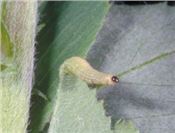Alfalfa Weevil Insecticide Resistance
DR. RIC BESSIN
LEXINGTON, KENTUCKY
Early spring is the start of alfalfa weevil season, and treatments are beginning to be applied to control this pest. There have been reports of poor weevil control with pyrethroid insecticides in some fields.
There can be several reasons why an insecticide application performs poorly, including incorrect rates due to improper calibration, the wrong type of pesticide was used, or the timing of application was off. But in these instances, the producers indicated they had used the same product for a number of years, and those products are not working like they had in the past.
Ruling Out Resistance Failure
Before concluding insecticide resistance when an application fails, the first step is to rule out other potential causes of the failure.
Make sure that the correct pesticide was used, confirm that the rate used was what was intended, and that the timing was correct to control the pest. With very high populations or larger stages of pests, it may take the highest labeled rate to get good control. Once other potential causes of insecticide failure have been ruled out, begin to look at causes that can lead to development of insecticide resistance.
Factors in Insecticide Resistance
Two factors are often associated with the development of insecticide resistance.
• The first is over-reliance on insecticidal control of pests in place of other non-chemical tactics. In this situation, producers may be using calendar applications in place of pest monitoring and economic thresholds. Pest monitoring may reveal that the pest is not present at levels requiring chemical control or it may suggest delaying an application to allow natural enemies time to make a greater impact with biological control. Other non-chemical tactics should be considered in order to reduce the selection pressure that drives the development of insecticide resistance.
• The other factor that favors the development of insecticide resistance is a field history of extensive use of a single insecticide or a single insecticide mode of action (same IRAC insecticide group) used repeatedly over a number of years. A common characteristic in fields with insecticide failures for alfalfa weevil was exclusive use of an insecticide with the same mode of action for more than 15 years.
However, this does not confirm insecticide resistance; follow up laboratory studies would be required. In these instances, poor control was observed with pyrethroid insecticides for alfalfa weevil. If an insecticide is still warranted in these fields, an insecticide from another mode of action group must be used. Fortunately, we have alternative modes of action labeled for this pest on alfalfa.
Producers need to use this as a lesson so that they can avoid pesticide resistance in the future. First, relying on pest monitoring to make insecticide application decisions helps to reduce the selection pressure favoring development of resistance. When you do spray, you must switch to different modes of action (IRAC insecticide groups) with each subsequent application. Since alfalfa weevil has a single generation per year, this would mean changing insecticide modes of action each year. Ideally, you should use three insecticide modes of action in rotation. This will help to delay or prevent the development of insecticide resistance. ∆
DR. RIC BESSIN: Entomology Extension Specialist, University of Kentucky

Figure 1. Alfalfa weevil is a key pest of first-cutting alfalfa. There have been increasing reports of poor control with pyrethroid insecticides.
Photo: Ric Bessin, UK